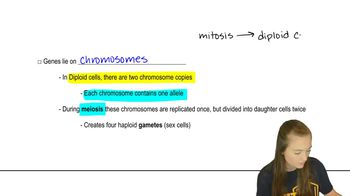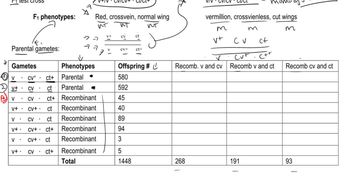Certain varieties of chrysanthemums contain 18, 36, 54, 72, and 90 chromosomes; all are multiples of a basic set of nine chromosomes. How would you describe these varieties genetically? What feature do the karyotypes of each variety share? A variety with 27 chromosomes has been discovered, but it is sterile. Why?
Table of contents
- 1. Introduction to Genetics51m
- 2. Mendel's Laws of Inheritance3h 37m
- 3. Extensions to Mendelian Inheritance2h 41m
- 4. Genetic Mapping and Linkage2h 28m
- 5. Genetics of Bacteria and Viruses1h 21m
- 6. Chromosomal Variation1h 48m
- 7. DNA and Chromosome Structure56m
- 8. DNA Replication1h 10m
- 9. Mitosis and Meiosis1h 34m
- 10. Transcription1h 0m
- 11. Translation58m
- 12. Gene Regulation in Prokaryotes1h 19m
- 13. Gene Regulation in Eukaryotes44m
- 14. Genetic Control of Development44m
- 15. Genomes and Genomics1h 50m
- 16. Transposable Elements47m
- 17. Mutation, Repair, and Recombination1h 6m
- 18. Molecular Genetic Tools19m
- 19. Cancer Genetics29m
- 20. Quantitative Genetics1h 26m
- 21. Population Genetics50m
- 22. Evolutionary Genetics29m
6. Chromosomal Variation
Chromosomal Mutations: Aberrant Euploidy
Problem 22b
Textbook Question
Two experimental varieties of strawberry are produced by crossing a hexaploid line that contains 48 chromosomes and a tetraploid line that contains 32 chromosomes. Experimental variety 1 contains 40 chromosomes, and experimental variety 2 contains 56 chromosomes.
How many chromosomes from the hexaploid line are contributed to experimental variety 1? To experimental variety 2?
 Verified step by step guidance
Verified step by step guidance1
Determine the ploidy level of the hexaploid line and the tetraploid line. The hexaploid line has 48 chromosomes, so each set of chromosomes (haploid set) contains 48 ÷ 6 = 8 chromosomes. Similarly, the tetraploid line has 32 chromosomes, so each haploid set contains 32 ÷ 4 = 8 chromosomes.
Understand that the experimental varieties are hybrids, meaning they inherit chromosomes from both the hexaploid and tetraploid lines. The total number of chromosomes in each experimental variety is the sum of contributions from the hexaploid and tetraploid lines.
For experimental variety 1, which contains 40 chromosomes, let the number of chromosomes contributed by the hexaploid line be x. The remaining chromosomes (40 - x) must come from the tetraploid line. Set up the equation: x + (40 - x) = 40.
For experimental variety 2, which contains 56 chromosomes, let the number of chromosomes contributed by the hexaploid line be y. The remaining chromosomes (56 - y) must come from the tetraploid line. Set up the equation: y + (56 - y) = 56.
Solve each equation to determine the number of chromosomes contributed by the hexaploid line to experimental variety 1 (x) and experimental variety 2 (y). Ensure that the total number of chromosomes in each variety matches the given values (40 for variety 1 and 56 for variety 2).
 Verified video answer for a similar problem:
Verified video answer for a similar problem:This video solution was recommended by our tutors as helpful for the problem above
Video duration:
3mPlay a video:
Was this helpful?
Key Concepts
Here are the essential concepts you must grasp in order to answer the question correctly.
Ploidy Levels
Ploidy refers to the number of sets of chromosomes in a cell. In this case, the hexaploid line has six sets of chromosomes (48 total), while the tetraploid line has four sets (32 total). Understanding ploidy is essential for determining how many chromosomes are contributed by each parent in a cross.
Recommended video:
Guided course

Diploid Genetics
Chromosome Contribution in Hybridization
When two different ploidy lines are crossed, the resulting hybrids will have a combination of chromosomes from both parents. The total number of chromosomes in the offspring can be calculated by adding the contributions from each parent, which is crucial for solving the question about the chromosome counts in the experimental varieties.
Recommended video:
Guided course

Chromosome Structure
Chromosome Counting in Genetic Crosses
Counting chromosomes in genetic crosses involves understanding how many chromosomes each parent contributes to the offspring. In this scenario, we need to determine how many chromosomes from the hexaploid line are present in each experimental variety, which requires basic arithmetic based on the total chromosome counts of the parents and offspring.
Recommended video:
Guided course

Trihybrid Cross
Related Videos
Related Practice
Textbook Question
490
views


